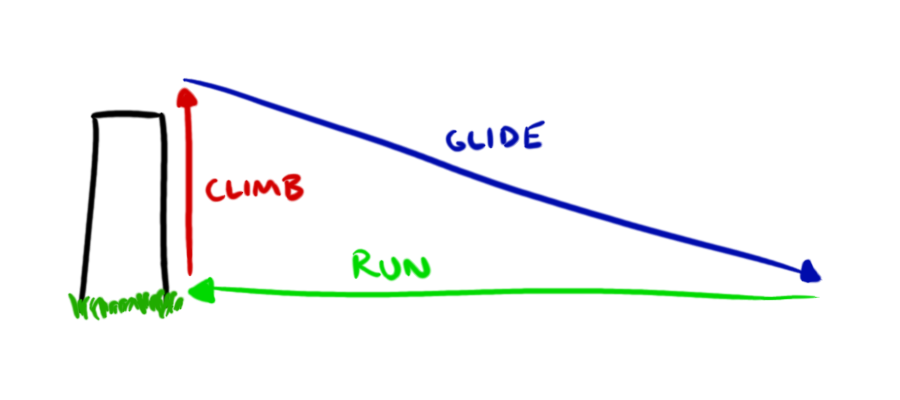 Paraglider Paraphysics
Paraglider Paraphysics
So, last Friday I got the Nintendo Switch, and The Legend of Zelda: Breath of the Wild. At this point, I've put 30+ hours into the game, and I can say with some confidence that it's really, really good (not sure yet whether it beats my favorite Zelda games, Majora's Mask and A Link to the Past). Good enough that halting my playthrough of it to write up this post is torturous. But, Fizzix Phriday must go on, and there is one thing that has bothered me, in the back of my brain, about the much-touted physics engine of Breath of the Wild. So, to continue in the series of "Austin ruins everything," as I have already done with Mass Effect, The Flash, and Sonic the Hedgehog, I'm now going to nitpick away at some less-than great physics in Breath of the Wild. Because I wreck everything that I love.
One of the main mechanics (which is so much fun to do) in Breath of the Wild is hiking or climbing up to a very high point (tower, mountain, etc.), surveying the landscape, noting something that looks like it deserves your investigation, and then leaping off said high point and using a paraglider to glide effortlessly to your destination (or realize that the point was so much further away than you realized, run out of stamina, and fall). This, in and of itself, is not a problem. What is the problem is the size of Link's (the player-character hero of the game) paraglider. It's really... not very big. From the screenshots I've taken of the game (which is gorgeous, by the way), it's a roughly trapezoidal shape that's about Link's height on its longer side. Assuming that Link is probably six feet tall, and being very generous and giving the paraglider a rectangular shape instead (also because this makes the math easier), this puts the surface area of the paraglider at about 18 square feet (the paraglider appears to be about half as long as it is wide). This, to my (somewhat) trained physics eye, struck me as wrong. But in order to see why, let's look at how a real-life paraglider works.
For a non-powered paraglider or hang glider (or even a paper airplane), there are three forces that are involved with its flight: gravity (which pulls it down), lift (which pulls it up), and drag (which pulls it against the direction that it's traveling). To be an effective glider, lift must cancel, or nearly cancel, the force of gravity (otherwise you still fall, you just accelerate downward at a slower rate). Now, lift works in a neat and somewhat physically complicated way, but its useful to know that the lift on a wing or airfoil is related to the speed at which air is flowing over it. The faster the air moves, the more lift it can generate. The other factors involved are the surface area of the wing/airfoil/paraglider, the density of the air, and the coefficient of lift, which is a constant based upon the shape of the airfoil, and what is called the angle of attack, or the angle at which the airfoil is cutting through the air relative to the plane of the ground. The full equation for lift is this:

Now, Breath of the Wild already gets the angle of attack wrong, as they have Link holding the paraglider such that it will generate a lot of drag moving through the air. You're probably already familiar with how this works if you've ever made a paper airplane. But let's assume instead that he's using an optimal angle of attack for his airfoil. The question remains: is what is represented in the game physically realizable as a paraglider? The answer is probably no, but I ran some experiments anyway to find out.
So, if we assume optimal angle of attack for the coefficient of lift, and standard air density, that leaves us with surface area of the airfoil and velocity to tackle. Well, I already guesstimated the surface area of the airfoil, but how do we determine velocity? It's by far the most important part of the equation (note that it's squared, so the equation will vary the most with changes to velocity, as opposed to all other factors), so we need this to be as close to right as possible. Well, we can solve this using in-game experiments, timers, and triangles.
There's nowhere in-game that gives you a distance, in either metric or imperial, between two points. However, what we can use to figure that out is a timer, and an estimate of Link's running speed. According to this source, the average human can run at speeds of 15mph for short periods. Well, when you run as Link, it uses up stamina, which, when it runs out, Link need to stop and take a breather. So we can assume that his running is that "short distances" speed of 15mph. We can now use this known speed to get the distance between two points: just run, record the time it takes, and use distance = rate * time to figure it out. Now we're getting somewhere.
Knowing this, here's the experiment that I devised and repeated multiple times and at multiple locations: I would find a stretch of level ground (the desert was one of the best places for this), that had some kind of vertical surface (pillar, tower, wall) that I could climb. I would climb to the top of the tower, and time how long it took (assuming that Link is an excellent climber (because he can climb just about anything), I can say that his climbing speed is a little over 1mph). Using the distance formula, I can determine how high this object is. Next, I would leap off the object and glide in a straight line until I hit the ground, timing the time I was in the air. I now have a time it took, but no distance. This is where triangles come into play. I would turn and run back, in a straight line, to the surface I jumped off of, and time the run. This gave me the horizontal distance I traveled. Using these two legs of a triangle, it's a simple matter of using the Pythagorean Theorem to determine the distance I paraglided (which is the hypotenuse of the triangle). Now, I can just use that distance formula, adjusted slightly to be velocity (rate) = distance / time, and I have the velocity of my paragliding, the last component in the lift equation.

So, how does it stack up? After numerous trials, I determined my average gliding velocity to be 36 feet per second, or about 25 miles per hour. Using ideal conditions for the other components of the lift equation, we get a lift force of about 185 Newtons. Now, to be as nice as we can to Zelda, I'm going to ignore all the weight of the equipment that Link carries (as most of it seems to disappear into hammerspace, excepting the items you have equipped, which are visibly on his back), and just factor in Link's own mass for the downward force (even ignoring the weight of the paraglider itself). The average weight for a healthy adult male of six feet is between 140 and 183 pounds, and, as Link is pretty muscular, we'll place him at the high end at 183 lbs. As pounds are already a measurement of force, we just need to convert them to Newtons to compare it to the lift generated by the paraglider. One pound is 4.45 Newtons. We can all see where this is going: 183 lbs is 814 Newtons—over four times the lift force being generated by the paraglider. Link would not be able to glide gracefully, he would simply fall at a slightly slower rate: about 24 feet per second per second, rather than the traditional 32 (7.5 m/s2 as opposed to the normal 9.8).
Zelda, though, unlike Mass Effect (which was a Sci-Fi game), has an out. As most of the Legend of Zelda games are Sword and Sorcery stories, the paraglider could simply be magically generating more lift. Problem solved. Magic fixes everything.
Please excuse this weak conclusion, as I desperately need to wrap up and get back to playing Breath of the Wild.
